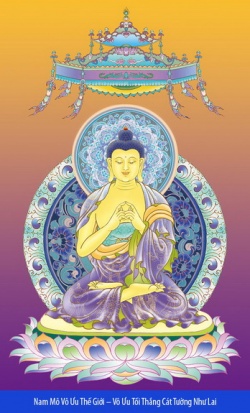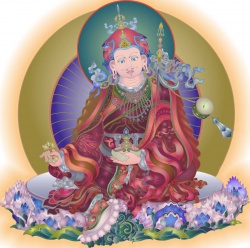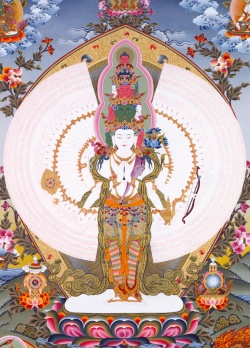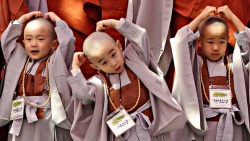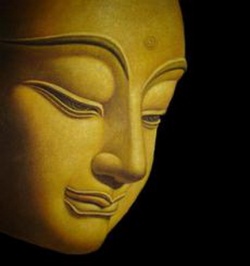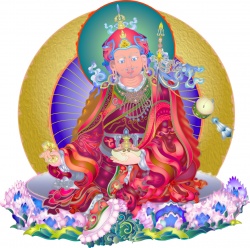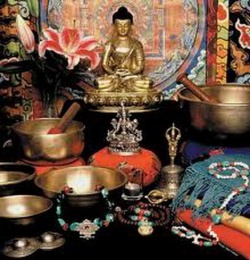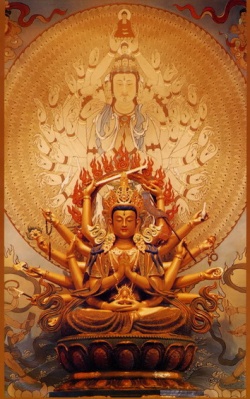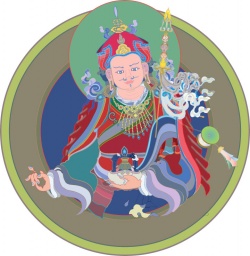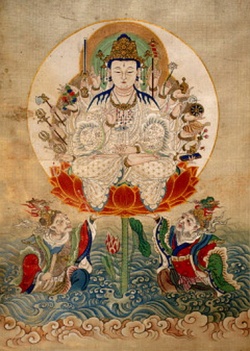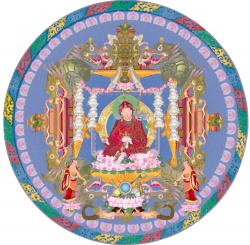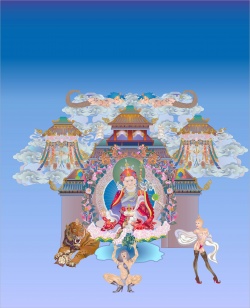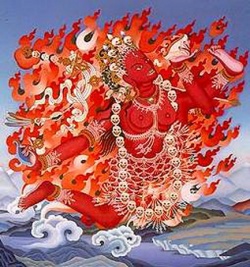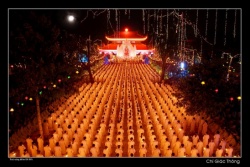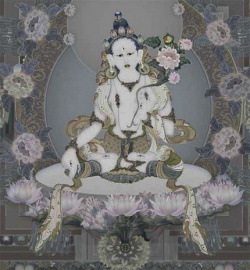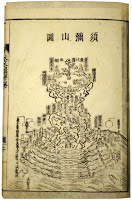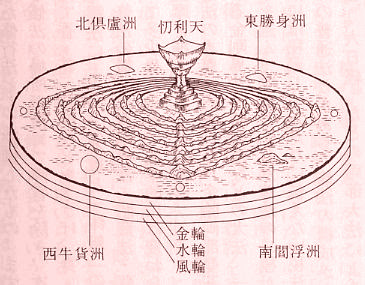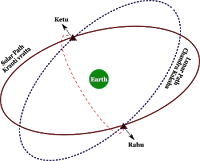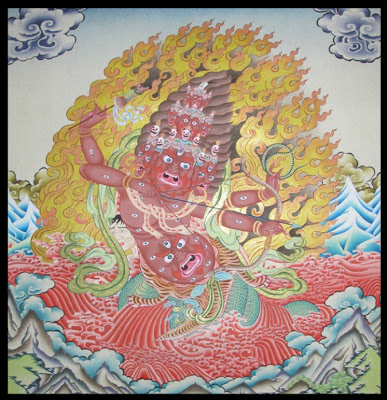Difference between revisions of "Astrology and Astronomy in Buddhism"
m (Text replacement - "]]]" to "]])") |
|||
| (One intermediate revision by the same user not shown) | |||
| Line 54: | Line 54: | ||
Here we might take a [[moment]] to consider the cosmography of {{Wiki|ancient India}} from which the [[cosmos]] were [[thought]] to be observed. The Sūrya-siddhānta presents a geocentric model where the [[earth]] is a {{Wiki|globe}} fixed in [[space]] and orbited by the {{Wiki|sun}}, [[moon]] and {{Wiki|planets}}. However, this is completely different from the alternative models of cosmography where [[Mount Sumeru]] ([[Meru]]), a vast hourglass-shaped mountain, is the center of the [[world]] system and surrounded by [[four continents]] [[rising out]] of a disc covered in vast ocean. The [[four continents]] are [[Pūrvavideha]] ([[east]]), [[Jambudvīpa]] ([[south]]), [[Aparagodānīya]] ([[west]]), [[Uttarakuru]] ([[north]]). We are said to live on [[Jambudvīpa]]. This was the [[Wikipedia:canonical|canonical]] model for [[Buddhists]] all around {{Wiki|Asia}} up until relatively recently. [[Vasubandhu]] in the [[Abhidharma-kośa-bhāsya]] describes the layout as follows: | Here we might take a [[moment]] to consider the cosmography of {{Wiki|ancient India}} from which the [[cosmos]] were [[thought]] to be observed. The Sūrya-siddhānta presents a geocentric model where the [[earth]] is a {{Wiki|globe}} fixed in [[space]] and orbited by the {{Wiki|sun}}, [[moon]] and {{Wiki|planets}}. However, this is completely different from the alternative models of cosmography where [[Mount Sumeru]] ([[Meru]]), a vast hourglass-shaped mountain, is the center of the [[world]] system and surrounded by [[four continents]] [[rising out]] of a disc covered in vast ocean. The [[four continents]] are [[Pūrvavideha]] ([[east]]), [[Jambudvīpa]] ([[south]]), [[Aparagodānīya]] ([[west]]), [[Uttarakuru]] ([[north]]). We are said to live on [[Jambudvīpa]]. This was the [[Wikipedia:canonical|canonical]] model for [[Buddhists]] all around {{Wiki|Asia}} up until relatively recently. [[Vasubandhu]] in the [[Abhidharma-kośa-bhāsya]] describes the layout as follows: | ||
| − | Nine great [[mountains]] rest on the [[sphere]] of {{Wiki|gold}}. In the center there is [[Meru]]; concentrically, the other seven are arranged around [[Meru]]; [[Nimindhara]] [[forms]] the exterior rim that envelops [[Meru]] and the six inner wall-mountains - whence its [[name]]. Beyond | + | Nine great [[mountains]] rest on the [[sphere]] of {{Wiki|gold}}. In the center there is [[Meru]]; concentrically, the other seven are arranged around [[Meru]]; [[Nimindhara]] [[forms]] the exterior rim that envelops [[Meru]] and the six inner wall-mountains - whence its [[name]]. Beyond ([[Nimindhara]]) lie the [[four continents]]. Enveloping all is [[Cakravāḍa]], thus named because it encircles the [[universe]] with its four continent [sic] and also because it has the [[form]] of [[a wheel]].<ref>{{Nolinking|Vasubandhu, Abhidharma-kośa-bhāsya. Vol. 2. Translated into French by Louis de La Vallee Poussin, English translation by Leo M. Pruden (Berkeley, CA: Asian Humanities Press, 1991), 452.}}</ref> |
This is perhaps best illustrated as a diagram: | This is perhaps best illustrated as a diagram: | ||
Latest revision as of 22:32, 3 April 2016
Astrology and Astronomy in Buddhism
By Indrajala (Jeffrey Kotyk)
As we discussed in an earlier post, Buddhist Sorcery and Astrology in East Asia, astrology formed a key component in East Asian Buddhism alongside sorcery and other occult practices such as rain summoning. Here I want to take a closer look at the details and significance of astrology in Buddhism and in particular in East Asia.
The Chinese Buddhist canon in this respect is valuable as the chronological introduction of Buddhist texts related to astrology as translated into Chinese simultaneously reflect the development of astrological literature in India. Indian texts generally lack a sense of history whereas in China the translations are normally dated to a dynasty period at minimum and assigned a translator whose dates can normally be known. This allows us to see, limited but nevertheless evident, the gradual absorption of astrology into Buddhism.
In China the practice of astrology goes back long before Buddhism was introduced into China (around the first century CE). Traditionally Chinese thought divided the study of the stars into lifa 曆法 (calender science) and tianwen 天文 (the study of the stars, including cosmography and omen interpretation). One might suggest these correspond to astronomy and astrology, but it would be misleading given what the latter encompasses. Nevertheless, modern concerns aside, Chinese civilization took the omens of the land and sky very seriously. It is thus not surprising that Chinese Buddhists would take an interest in Indian astrology through the medium of Buddhism. The state as well was always interested in the skies and how they might affect things down below and more importantly the foundations of imperial power.
It was during the Eastern Han Dynasty (25-220) a bureau of astronomy was established which survived two millennia until the Qing Dynasty (1644-1912). Some members of the upper echelons who were charged with the task of observing the sky and had direct access to the emperor, advising him according to their own observations. The Later Book of Han 後漢書, a history of the Eastern Han, details the tasks of the office of tai-shiling 太史令 (court astronomer), an upper-middle appointment, as follows:
- 掌天時、星曆。凡歲將終,奏新年曆。凡國祭祀、喪、娶之事,掌奏良日及時節禁忌。凡國有瑞應、災異,掌記之。
- He is charge of [monitoring] the Mandate of Heaven and the calendar. He reports on the new year's calendar whenever the year is about to conclude. He is in charge of reporting good days and taboo times whenever there are national sacrifices, funerals or weddings. He is in charge of recording auspicious responses, calamities and abnormalities whenever the country has them.
His monthly salary came to 3500 cash in 106 CE. To put that into perspective, the accessory clerks made 400 cash per month while the highest member on the salary list comes out with 17,500 cash, the next best with 9000. So, while the court astronomer was not the top paid member of the bureaucracy, clearly his services were important enough to merit a comfortable income.[1] There were also of course many staff members under him who did the observations and paperwork, their collective efforts resulting in a database that would be used for many centuries thereafter.[2]
Given the high value placed on astrology at the highest levels of state, it should be unsurprising that Buddhists in China would come to adopt and employ such arts for their own purposes. The upper echelons of Buddhist clergy connected with state leadership could presumably point to exotic forms of Indian astrology as potentially useful and thus receive funding and resources for their projects.
Astrology in India had of course been long existent by the time of unified China and although it seems early Buddhism had little to do with it, Buddhists in due course assimilated it. Bill Mak in his paper “Indian Jyotiṣa through the lens of Chinese Buddhist Canon” explains the development as follows (see p6):
- Broadly speaking, we can see that jyotiṣa materials are often incorporated into Buddhist texts somewhat apologetically in the early phase. In the Mahāyāna case, jyotiṣa knowledge is often considered a form of expedient (upāya), employed for the benefits for the sentient beings though they are not considered genuine Buddhist teachings per se. In the late stage, in particular among the so-called Tantric works, they are seen as authentic Buddhist teachings and are often employed directly with no justification given or required.
Monier-Williams Sanskrit-English Dictionary defines jyotiṣa as “the science of the movements of the heavenly bodies and divisions of time dependant thereon, short tract for fixing the days and hours of the Vedic sacrifices”. In English it can refer to either astrology or astronomy. In actuality up until recently such a distinction was not really made in most cultures.
Such an art never remained static. The scholar David Edwin Pingree (1933-2005) after a lifetime of study divided Indian astrology into four categories based on the origins of the material:
- I. Vedic (c.1000-400 BCE)
- II. Babylonian (400 BCE-200 CE): Vedāṅgajyotiṣa
- III. Greco-Babylonian (c200-400): Yavanajātaka
- IV. Greek (c400-1600): Āryabhaṭīya.
- V. Islamic (c1600-1800)
These distinctions are actually to be found in the translations of Indic texts in the Chinese canon as Mak shows. However, he notes the flaw in Pingree's model is an overemphasis on Babylonian elements, though nevertheless this scheme does show the cosmopolitan quality of Indian astrology throughout the ages. It should be noted that alternative theories have been suggested. Richard Thomson argued that Vedic astronomy was primarily indigenous to India and was not imported from abroad:
- Vaiṣṇava tradition indicates that the jyotiṣa śāstra is indigenous to Vedic culture, and this is supported by the fact that the astronomical siddhāntas do not acknowledge foreign source material. The modern scholarly view that all important aspects of Indian astronomy were transmitted to India from Greek sources is therefore tantamount to an accusation of fraud. Although scholars of the present day do not generally declare this openly in their published writings, they do declare it by implication, and the accusation was explicitly made by the first Indologists in the early nineteenth century.
Thompson goes on to suggest that Greeks and the people of the India once shared a common culture which included astronomy, though over the course of the kaliyuga there emerged large differences in their cultures, though many common features still remained due to their shared heritage and later relations (the Vedic Indians and Greeks incidentally were both Indo-Europeans). The Greeks in fact regained astronomical knowledge through relations to India and the subsequent discovery of texts coupled with native creativity.[3]
Predictably, this does not agree with contemporary scholarship. The Greeks themselves in antiquity believed their knowledge came from either Babylon or Egypt, and contemporary scholarship traces most of it to the former:
- The omen-literature of ancient Mesopotamia included matter concerning the heavens, and when it was combined with the astronomical data derived from attempts to construct a calendar, horoscopal astrology developed, of which we have evidence from the fourth century BCE or slightly earlier. With the increased contact between this area and the Greek world after Alexander’s conquest of Persia, both the zodiac, in the fourth century BCE, and Babylonian data and methods in astronomy and astrology, in the following centuries, were absorbed by the Greeks. They transformed both astronomy and astrological cosmology with kinematic models of the universe. … The contribution of Ancient Egypt was limited to a standard calendar, and the original form of the decans.[4]
Contemporary research would indicate a primarily Babylonian origin for Alexandrian Greek astronomical/astrological models (incidentally, for a good article on this see the Internet Encyclopedia of Philosophy). This is relevant because these models often resemble classical Indic ones, which has led many to conclude that the Indians obtained their astronomical knowledge from the Babylonians and Greeks. In light of the other apparent influences, such as Greek influences in northwest India leading to the development of statues of the Buddha, the contemporary mainstream theory concerning the origins of much Indic astronomy seems the most realistic. The relationship between Indian and Greek civilizations of course was not one way, which Thomas McEvilley explores in his work The Shape of Ancient Thought.
Nevertheless, Thompson's theory might not be so far-fetched given that Indo-Aryans, with gods named Indra and Varuna, commanded a state called Mitanni (1500-1300 BCE) which ruled over the cities of Assur and Assyria during the Bronze Age. Is it possible the Babylonians learnt some of their astronomy from these Indo-Aryans? We can only speculate, and I say this just to throw it out as a possibility. It should be recognized that Richard Thompson was a member of the Bhaktivedanta Institute, a wing of the International Society for Krishna Consciousness (ISKCON). As an advocate of traditional Vaiṣṇava views he insisted on identifying an indigenous Indian source for ancient jyotiṣa knowledge, hence he was emotionally invested in maintaining a native Indian source for astronomical knowledge. I personally do not feel his arguments holds up against evidence.
In any case, Buddhists knowingly absorbed the astrological models and data available to them in India regardless of their ultimate origins, be they native or foreign. It does not appear they knew or paid much interest. Buddhist scriptures, in particular those translated into Chinese from the second century CE through to the tenth, preserved the development of jyotiṣa literature, which makes them quite valuable in the scholarly study of Indian astrology. However, it still begs the question as to why this knowledge was considered valuable? Put simply, if you lived in an age where most people believed the stars had a profound impact on life on earth and/or truly reflected present circumstances and things to come, it often being a matter of life and death, then astrology naturally possessed a utilitarian value, especially to the state.
Here we might take a moment to consider the cosmography of ancient India from which the cosmos were thought to be observed. The Sūrya-siddhānta presents a geocentric model where the earth is a globe fixed in space and orbited by the sun, moon and planets. However, this is completely different from the alternative models of cosmography where Mount Sumeru (Meru), a vast hourglass-shaped mountain, is the center of the world system and surrounded by four continents rising out of a disc covered in vast ocean. The four continents are Pūrvavideha (east), Jambudvīpa (south), Aparagodānīya (west), Uttarakuru (north). We are said to live on Jambudvīpa. This was the canonical model for Buddhists all around Asia up until relatively recently. Vasubandhu in the Abhidharma-kośa-bhāsya describes the layout as follows:
Nine great mountains rest on the sphere of gold. In the center there is Meru; concentrically, the other seven are arranged around Meru; Nimindhara forms the exterior rim that envelops Meru and the six inner wall-mountains - whence its name. Beyond (Nimindhara) lie the four continents. Enveloping all is Cakravāḍa, thus named because it encircles the universe with its four continent [sic] and also because it has the form of a wheel.[5]
This is perhaps best illustrated as a diagram:
The sun and moon are described as "discs" which move upon the wind, or the collective force of the actions of beings. All astral bodies revolve around Meru. The sun and the moon move at a level equal to the summit of Yugandhara (the second mountain surrounding Meru). It is said, “When it is midnight in Uttarakuru, the sun sets in Pūrvavideha, it is midday in Jambudvīpa, and it rises in Godānīya, and so on.”[6] Hence Mount Meru blocks sunlight causing night on the opposite side (Uttarakuru is to the north while Jambudvīpa to the south, the sun moving around the flat world clockwise around Mount Meru).
The Abhidharma-kośa-bhāsya describes this as an actual physical model of the universe. It is not figurative nor symbolic here, though some later authors did not take this model literally (see Henning's page on the Kālacakra World Model). The Buddha indeed spoke of such a model of the world, though I believe much of it actually reflects areas of reality beyond normal perception given that these locations are said to be where devas and other such immaterial beings reside (I might discuss this in a future post). The Meru cosmography lasted until modern times, though I hear some peoples in remote regions like in the Himalayas still insist on the classical model.
We can assume some Buddhists at some point had access to the Sūrya-siddhānta which as Thompson indicates speaks of a round earth, but as far as I know round earth theories played little to no role in the development of Buddhist astrology/astronomy.
Moving on, the Mātaṅga Sūtra 摩登伽經, translated into Chinese in 230 CE by Zhiqian 支謙, is the oldest known Indic sūtra translated into Chinese to include jyotiṣa elements such as the 28 nakṣatras, 9 grahas, monthly gnomic and the Metonic cycle. There was an earlier translation of the text done by An shigao 安世高 between 148-170 CE, though it is much shorter and does not contain astrological references. It is a brief sūtra about a daughter of a witch wanting marry the handsome Ānanda. The mother attempts to use witchcraft to trap and make him consummate a marriage, but fails. The girl becomes a bhikṣuṇī in the end and renounces her evil ways. Zhiqian's work picks up from here and extends the sūtra to include dialogue between characters from some long past time, including many teachings on astrology.
The 28 (sometimes 27) nakṣatras are constellations as listed in jyotiṣa literature (they are individually associated with days on the sidereal calendar of 27.321661 days). The 9 grahas (or navagraha), meaning “seizing or influencing the destinies of men in a supernatural manner” (see Monier-Williams), are the following celestial bodies:
English
|
|||
月
|
|||
熒惑
|
|||
辰星
|
gza' lhag
| ||
歲星
|
|||
太白
|
|||
鎮星
|
|||
羅睺
|
|||
彗星
|
Rāhu and Ketu are considered “shadow planets”. These are not recognized as existent by modern astronomy, though they do correspond with a quantity that is measured by modern astronomy: Rāhu is the ascending node of the moon and Ketu is the descending node of the moon. Consider the following:
- From a geocentric perspective, the orbit of the sun defines one plane passing through the center of the earth, and the orbit of the moon defines another such plane. These two planes are slightly tilted with respect to each other, and thus they intersect on a line. The point where the moon crosses this line going from celestial south to celestial north is called the ascending node of the moon. According to the Sūrya-siddhānta, the planet Rāhu is located in the direction of the moon's ascending node.[7]
Rāhu is further associated with solar and lunar eclipses:
- In the Vedic literature it is often mentioned that Rāhu causes solar and lunar eclipses by passing in front of the sun or moon. To many people, this seems to blatantly contradict the modern explanation of eclipses, which holds that a solar eclipse is caused by the passage of the moon in front of the sun and a lunar eclipse is caused by the moon's passage through the earth's shadow. However, the actual situation is somewhat more complicated than this simple analysis assumes. The reason for this is that the Sūrya-siddhānta presents an explanation of eclipses that agrees with the modern explanation but also brings Rāhu into the picture. This work explicitly assumes that eclipses are caused by the passage of the moon in front the sun or into the earth's shadow. It describes calculations based on this model that make it possible to predict the occurrence of both lunar and solar eclipses and compute the degree to which the disc of the sun or moon will be obscured. At the same time, rules are also given for calculating the position of Rāhu and another, similar planet named Ketu. It turns out that either Rāhu or Ketu will always be lined up in the direction of any solar or lunar eclipse. ... The positions assigned to Rāhu and Ketu correspond to the ascending and descending nodes of the moon - the points where the orbit of the moon (projected onto the celestial sphere) intersects the ecliptic, or the orbit of the sun. These nodal points rotate around the ecliptic from east to west, with a period of about 18.6 years. One of them must always point in the direction of an eclipse, since the moon can pass in front of the sun or into the earth's shadow only if the sun, moon and earth lie on a straight line.[8]
To clarify this further for those not terribly adept in astronomy like myself, let me quote the following from the Jyotish Vidya Google Group:
Eclipses only occur when the path of the sun and that of the moon crosses relatively to each other. The sun moves around the entire sky in one year covering entire zodiac. This path is known as ‘krāntivṛtta’ (ecliptic). The moon moves around the entire sky in 27 days, thus creating lunar path. These two path cross at ascending node called Rāhu and descending node called Ketu. These nodes exactly opposite, move very slowly from month to month. If the sun and moon are near to the same node Solar Eclipse takes place and if they approach the opposite node Lunar Eclipse occur. By considering these nodes to be planets, we record their motion against those of sun and moon. By this we can predict exactly eclipses. This is the intelligent method of our ancient Indian astrologers. This is how Rāhu and Ketu assumed much respected status among Indian mythology and hence religion.
It seems some asserted these were actual planets rather than merely being considered as such for the purposes of calculating when eclipses would occur. In any case, in astrology they play an important role and as such are included in the relevant works even in Chinese translation.
In mythology, Rāhu was the name of an asura who disguised himself as a deva to drink amṛta (ambrosia of the gods which halts aging and death). Sūrya (sun) and Candra (moon) reported this to Viṣṇu who beheaded Rāhu, though since the drink had been swallowed both his head and bodied continued to live. They were both blessed by Viṣṇu to become planets, but exact their vengeance against Sūrya (the sun) and Candra (the moon) by swallowing them at times (grahaṇa).
Rāhu incidentally makes an appearance in the Pāli canon in the Candima Sutta and Suriya Sutta. They are quite brief, so I will quote the first one in its entirety here:
- On one occasion the Blessed One was living near Savatthi, at Jetavana at Anathpindika's monastery. At that time Candima, the moon deity, was seized by Rahu, lord of Asura. Thereupon calling to mind the Blessed One, Candima, the moon deity, recited this stanza:
- i. "O Buddha, the Hero, thou art wholly free from all evil. My adoration to thee. I have fallen into distress. Be thou my refuge."
- ii. "O Rahu, Candima has gone for refuge to the Tathagata, the Consummate One. Release Candima. The Buddhas radiate compassion on the world (of beings)."
- Thereupon Rahu, Lord of Asuras, released Candima, the deity, and immediately came to the presence of Vepacitta, Lord of Asuras, and stood beside him trembling with fear and with hair standing on end. Then Vepacitta addressed Rahu in this stanza.
- iii. "Rahu. Why did you suddenly release Candima? Why have you come trembling, and why are you standing here terrified?"
- "I have been spoken to by the Buddha in a stanza (requesting me to release Candima). If I had not released Candima my head would have split into seven pieces. While yet I live, I should have had no happiness. (Therefore I released Candima)."
In Tibetan Buddhism he is called Za Rahula (gza' rA hu la) and functions as a Dharma protector, in particular in respect to the Nyingma and Dzogchen teachings. He is portrayed with nine heads, a lower body like a snake and upper body covered in eyes. He is aflame and wielding a bow. As follows:
Basically, in the greater Buddhist world Rāhu acts as an astronomical function, a shadow planet, a malicious entity and a guardian of the Dharma.
Now, returning to the Mātaṅga Sūtra, chapters five and six teach horoscopy and electional astrology. This is important to note because it demonstrates before the early third century CE Indian (or Central Asian?) Buddhism had adopted components of early Indic jyotiṣa (both the astrological and astronomical elements). It is unclear to me to what extent such an influence held in Buddhism on the whole around the Indian subcontinent. For example, did the mainstream Śrāvakayāna schools take much interest in such things? We know that they did concern themselves with the activities of worldly gods which visited the world on specified dates as shown in the Abhidharma Mahāvibhāṣā Śāstra, a key text of the Kashmir Sarvāstivāda school dated to around the 2nd century CE and attributed to Kātyāyanīputra:
- 《大毘婆沙論》:「問何故唯說三十三天。答以彼諸天數數雲集、論善惡事、故偏說之。謂彼諸天於白黑月,每常八日、若十四日、若十五日,集善法堂,稱量世間善惡多少。復次三十三天常共伺察造善惡者。見造善者,便擁護之;見造惡者,即共嫌毀。」
- Question – “Why only speak of thirty-three devas?” Answer – “The devas frequently gather to discuss good deeds and misdeeds. Hence the partial discussion of them. The devas during the waxing and waning moons on every eighth, fourteenth and fifteenth always gather in the hall of saddharma to weigh the amount of good deeds and misdeeds in the world. Furthermore, the thirty-three devas always together inspect the creators of good deeds and misdeeds. Seeing one who has created good deeds, they then protect them. Seeing one who has created misdeeds, they then together resent and ruin them.”
The ancient Indic month of 30 days was divided into two 15 day segments called the śukla-pakṣa (the waxing) and the kṛṣṇa-pakṣa (the waning). Therefore, in a given lunar month the thirty-three devas were expected to come on the following days: 8th, 14th, 15th, 23rd, 29th and 30th. This is not a far step away from electional astrology. Perhaps it was the minority Mahāyāna movement which took a step in that direction and adopted for their own purposes contemporary astrology. This is assuming of course the Mātaṅga Sūtra was specifically a Mahāyāna text, though in actuality it might not have been. It also includes the Gāyatri mantra from the Ṛg Veda:
| Oṃ bhūr bhuvaḥ svaḥ | 菴 浮 婆 蘇婆
|
tát savitúr váreṇ(i)yaṃ
|
旦 娑婆鬪 婆利茹
|
bhárgo devásya dhīmahi
|
被瞿 提婆斯 提麼
|
dhíyo yó naḥ pracodáyāt
|
提由 那 婆羅提那
|
This is identified as the “mantra of Brahmins” 婆羅門呪. It speaks much to the influences of Vedic culture on Buddhism by the early third century CE. At this point both mantras and astrological practices were already being introduced into Buddhism as normal and appropriate. It curiously also asserts the equality of the four castes, which perhaps says something about conflicting Vedic and Buddhist ideas – astrology and mantras had utilitarian value to Buddhist mystics, but the caste system was unacceptable. This indeed agrees with Johannes Bronkhorst's theory as presented in his work Buddhism in the Shadow of Brahmanism where he explains how Buddhists in India came to adopt not only Sanskrit, but various Vedic ideas to the point that they eventually came to see themselves as an offshoot of Vedic culture rather than having preceded it. While Buddhists generally retained a separate identity, they still nevertheless eventually adopted a diluted vision of society based on the caste system as advocated by the Brahmins who had come to command both religious and political authority.
A few centuries later the Mahāsaṃnipāta Sūtra 大集經 was translated in sections starting from the late fourth century to the late sixth. In it we find reference to the twelve zodiacal signs along with ample astrological data. Here we find the earliest use of the zodiac signs in the Chinese canon. Separate translators did their respective sections and hence the zodiac signs are semantically translated in one section and transliterated in another. They are as follows:
English
|
||
Meṣa
|
持羊之神
| |
Vṛṣa
|
持牛之神
| |
雙鳥
| ||
蟹神
| ||
Leo
|
師子之神
| |
秤量之神
| ||
Vṛścika
|
蝎神
| |
Dhanvin
|
射神
| |
磨竭之神
| ||
水器之神
| ||
天魚之神
|
We can therefore be assured that by the late fourth century these zodiacal signs had been introduced into Indic astrology – widespread enough for it to be adopted into Buddhist literature.
Some generations later the tantric literature emerges which accepts astrology as simply canonical and attributes it to the appropriate enlightened beings. One such case is the Sūtra on Mañjuśrī Bodhisattva and the Sage's Teaching on Auspicious and Inauspicious Times, Days, Good and Evil Constellations and Luminaries 文殊師利菩薩及諸仙所說吉凶時日善惡宿曜經, translated by Amoghavajra (705-774) in 759 and revised in 764 by disciple Yang Jing Feng 楊景風 under his master's guidance. This text is the foundation for the astrology tradition of Shukuyō 宿曜, which is still practiced in Japan today even on a popular level. It formed a key component to East Asian esotericism (Mijiao / Mikkyō 密教), most specifically in Japanese Shingon under Kūkai.
The text is divided into two fascicles. The first scroll has seven chapters.
Chapter one is an explanation of the emergence of the cosmos as well as the sun, moon, planets, 27 nakṣatras and 12 zodiac signs. The diameters of the seven luminous bodies (the sun, moon and five visible planets) are also included:
| Sun |
51 yojanas |
| Moon |
50 yojanas |
| Venus |
10 yojanas |
| Jupiter |
9 yojanas |
| Mercury |
8 yojanas |
| Mars |
7 yojanas |
| Saturn |
6 yojanas |
| Small stars |
1 krośa |
Depending on the source, a yojana is either 7 or 9 miles with 4 krośas equaling 1 yojana. A yojana is further defined as the distance a sovereign will travel in a day.
Chapter two explains the stars belonging to the 28 nakṣatras (constellations), their shape, associated deity and furthermore appropriate tasks on days associated with them, i.e., electional astrology (the number of nakṣatras reflect the number of days in a sidereal month). It further explains the qualities of individuals born under the individual constellations.
Chapter three provides a method for gauging potential friendships and prescribed activities day by day for individuals based on the constellations associated with their births.
Chapter four details auspicious and inauspicious activities on the seven days of the week. It further discusses how people with birthdays falling on specific days should behave as well as forecasts for harvests based on which day of the week falls on 5/5. It further lists potential calamities that might occur should an eclipse or earthquake occur on a given day of the week.
Chapter five details a secret forecasting method based on the seven days of the week tailored to the individual.
Chapter six discussed how the month is divided into the black 黑月 (kṛṣṇa-pakṣa) and white/bright 白月 (śukla-pakṣa) moons (waning and waxing), each being fifteen days, and the auspiciousness or inauspiciousness of each day. The data provided in the text can be graphed as follows:
Auspiciousness by constellation/weekday.
|
|||||
| śukla |
1 |
*
|
|||
| 2 |
*
|
||||
| 3 |
*
|
||||
| 4 |
Night
|
Night
| |||
| 5 |
*
|
||||
| 6 |
*
|
||||
| 7 |
*
|
||||
| 8 |
Daytime
|
Daytime
| |||
| 9 |
*
|
||||
| 10 |
*
|
||||
| 11 |
*
|
Night
|
Night
| ||
| 12 |
*
|
||||
| 13 |
*
|
||||
| 14 |
|||||
| 15 |
Daytime
|
Daytime
| |||
| kṛṣṇa |
1 (16) |
*
|
|||
| 2 (17) |
*
|
||||
| 3 (18) |
*
|
Night
|
Night
| ||
| 4 (19) |
|||||
| 5 (20) |
*
|
||||
| 6 (21) |
*
|
||||
| 7 (22) |
*
|
Daytime
|
Daytime
| ||
| 8 (23) |
|||||
| 9 (24) |
*
|
||||
| 10 (25) |
*
|
Night
|
Night
| ||
| 11 (26) |
*
|
||||
| 12 (27) |
*
|
||||
| 13 (28) |
*
|
||||
| 14 (29) |
Daytime
|
*
|
Daytime
| ||
| 15 (30) |
|||||
| -On all inauspicious days it becomes auspicious after noon. -On all inauspicious nights it becomes auspicious after midnight. | |||||
Note: in other texts devas descend to inspect people's virtues on the 8th, 14th, 15th, 23rd, 29th and 30th.
Finally, chapter seven names specific days and prescribes activities to be done on such days. It interestingly also names specific deities (Brahma, Vasu, Śiva and so on) who descend into the world. This would seem to imply offerings are made to that specific deity. For example, the 1st and 16th of the month are called “name establishment”. This is when Brahma descends into the world. On these days one should do good deeds, cultivate the path, seek sages as well as serve teachers and elders, though one should not travel far.
The second scroll of the text does not include chapter numbers. It provides further details on the aforementioned subject matter, two tables for finding a person's associated signs, additional proscriptions and prescriptions associated with the the 27 nakṣatras, zodiac signs, days of the week and so on.
The Chinese text itself is clearly an adapted version of an Indic text, or more likely several texts. It is credited to Mañjuśrī by virtue of the title, but he is quoted directly only once. It is not so much a sūtra, but really a manual of astronomy that is heavily endowed with Vedic aspects.
This demonstrates of course ongoing and quite strong Vedic influences in Mahāyāna. Vedic influences become even further digested by the tenth century when the Kālacakra Trantra emerges. I will not go into the details of that here, but I should like to recommend Edward Henning's site www.kalacakra.org which explains the subject matter extensively (for information on the calendar see here).
Now, setting aside modern critique of the astronomical model presented above, what relevance did such a cosmos have for its observers, and more specifically Buddhists in ancient India? Astrology especially might seem out of place at first, even adharma, given the core teachings of Śākyamuni Buddha. There are even records of proscriptions against such arts in early Buddhism. Nevertheless, in time some Buddhists organically developed a perspective of the cosmos that perhaps made astrology sensible and realistic. Consider that Vasubandhu in the Abhidharma-kośa-bhāsya states, “The collective force of the actions of beings produces the winds which create (nirmā) the moon, the sun and the stars in heaven.”[9] He further states,
Who created the variety of the world of living beings and the receptacle-world which we have described in the preceding chapter?
- It was not a god who intelligently created it.
- The variety of the world arises from the actions of living beings.[10]
If the cosmos are indeed a product of the karma of beings, then naturally they could very well reflect present activities and forthcoming events – so above, so too below. From this perspective heaven and earth are not meaningless material phenomena, but teleologically rich entities which emerge as a result of beings' collective volitional actions, and consequently further reflect the present outcome and future of things to come. Such a worldview would predictably lead many to concern themselves with understanding that process and harnessing knowledge of it for their own ends.
In the Buddhist context astrology as such could be used for benevolent purposes. Just as Ptolemy argued, foreknowledge calms the soul. No doubt such a function was apparent to Buddhists. Buddhists would have seen their counterparts in contemporary society practising it and clearly many took an interest. The art was already available and well-developed by the third century CE, so it was easy enough to adopt it.
Of course many modern people will see such ideas as irrational and unscientific. Nevertheless plenty of eminent figures of the past took them seriously and scheduled their own lives and institutions around them. Many still do, especially amongst Tibetans. It might be unsettling for some that astrology has played a significant role in many traditions of Buddhism given the popular image of “Buddhism” as being thoroughly rational, even scientific. As we explored in early posts, sorcery (the summoning of benevolent deities for protection) likewise played a major role throughout Buddhist history in East Asia and elsewhere. Historically, it was these practices, not philosophy or meditation, that really formed the core activities of state supported Buddhism in much of Asia. In the case of China where astrology and divination were key activities of the court it should not be surprising that Buddhist institutions readily adopted the same practices for their own purposes.
At the end of the day it was sorcerers and astrologers who really secured stability and support for Buddhism in East Asia. We will take a look at some of those figures in detail in a future post.
Footnotes
- ↑ See Han Bielstein, The Bureaucracy in Han Times (New York, NY: Cambridge University Press, 1980), 131.
- ↑ See Lloyd's paper “The Varying Agenda of the Study of the Heavens: Mesopotamia, Greece, China” in Asia Major, 85.
- ↑ Richard L. Thompson, Vedic Cosmography and Astronomy (Delhi, India: Motilal Banarsidass, 2004), 15-17.
- ↑ Tamsyn Barton, Ancient Astrology (London, UK: Routledge, 1994), 30.
- ↑ Vasubandhu, Abhidharma-kośa-bhāsya. Vol. 2. Translated into French by Louis de La Vallee Poussin, English translation by Leo M. Pruden (Berkeley, CA: Asian Humanities Press, 1991), 452.
- ↑ Ibid., 461.
- ↑ Richard L. Thompson, 14.
- ↑ Ibid., 97-100.
- ↑ Abhidharma-kośa-bhāsya, Vol. 2, 460.
- ↑ Ibid., 551.
